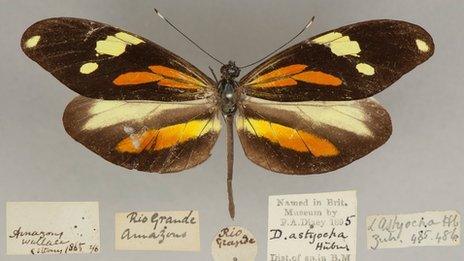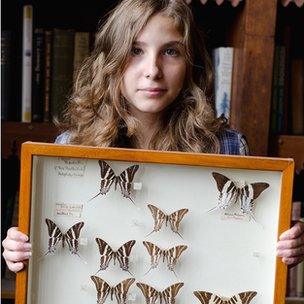'Priceless' butterflies found at Oxford museum
- Published

The Amazon Dismorphia was re-discovered by a work experience student
An A-level student on work experience at an Oxford museum has found rare examples of butterflies lost since the 19th Century.
Athena Martin, aged 17, has found butterfly specimens described as "priceless" by the Oxford University Museum of Natural History.
They had been brought back from South America by a Victorian naturalist.
Many of the butterflies were thought lost at sea in the 1850s.
Ms Martin's discoveries came during the summer when she was taking part in a science-related work experience project.
Lost at sea
The school girl, who wants to study zoology at university, found and identified butterflies collected by the naturalist Alfred Russel Wallace.

Athena Martin with some of the butterflies in the collection
They had been buried away in more than 3,000 separate drawers of butterflies at the museum.
Painstakingly going through the collection turned up more than 300 of Wallace's butterflies.
The biggest find made by the work experience student was a butterfly called Dismorphia, brought from the Amazon and which had remained undiscovered and unacknowledged within the museum since the end of the 19th Century.
The confusion over Wallace's collection had been caused by a fire breaking out on his ship when he was bringing back specimens from South America in 1852 - and it had been believed that most of his butterfly collection had been lost.
"The re-discovered Amazonian specimen in particular is a significant find in terms of the history of science and natural history collecting in the 19th Century," says Dr James Hogan of the Hope Entomological Collections, which are based at the museum.